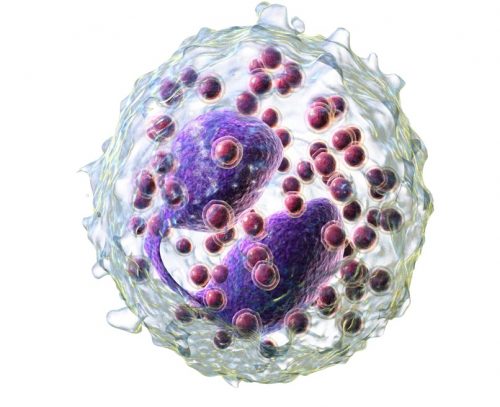Image courtesy of Bruce Blaus.
Despite its name, microRNA helps the body on a macro scale. The small molecule, only about 22 nucleotides long, plays an important role in the regulation of gene expression by binding to mRNA at certain points in its sequence. At the Yale School of Medicine, Shervin Takyar and his team investigated the role microRNAs played in controlling eosinophilia through endothelial cells. Eosinophilia occurs when large numbers of white blood cells called eosinophils are recruited to a site in the body, leading to the allergic airway reaction characteristic of asthma and chronic rhinosinusitis (CRS).
The paper’s first point of analysis was investigating which inhibitory factors interact with VEGF (vascular endothelial growth factor). “We looked at a vascular factor [endothelial cells] and inhibition, investigating their role in asthma and CRS,” Takyar explained. Takyar’s team found that microRNA-1 levels went down when VEGF went up. “The next step[s] [were] figuring out first, whether microRNA-1 levels are important in the disease, and second, why,” Takyar said. The team was then able to show, through biological and mathematical models, that the molecule was important. They also proved that asthmatic eosinophilia reactions were reduced by increased levels of microRNA-1 in the blood.
Takyar and his team recreated the conditions first in transgenic mice and in an engineered lentivirus (retroviruses with long incubation periods) and then created a model for a human vessel in the lab. “We isolated endothelial cells and reversed the change [in microRNA levels], and only changing microRNA-1 levels in these cells [could] decrease the features of asthma,” Takyar said.
The next step was to understand where the molecule was acting in the cell. The results revealed that microRNA was inhibiting the asthmatic reaction by acting in a known protein complex, the RNA induced silencing complex. This was especially hard to investigate because microRNA cannot be tagged, since this would inhibit the molecule from entering the complex. Within the complex, there is an Argonaute protein, which acts as a “matchmaker” for microRNA and the inhibiting molecules; this protein was used to understand how microRNA was influencing the eosinophilic reaction. “We captured the Argonaute when microRNA was entering to see what microRNA-1 was acting on,” Takyar said. With this strategy, the team identified four genes that control eosinophilia, an important breakthrough.
After this discovery, the researchers extracted cells from humans with CRS and created a model for the human endothelium environment. In this model, they passed eosinophils over the cells to see how many would stick to them in varying levels of microRNA. As expected, they found that in increased levels of microRNA, less eosinophils would adhere to the cells, which revealed the mechanism of action for the inhibition of the symptoms.
To the researchers, the discovery shows promise for clinical treatments. “Right now, we are starting a collaboration with clinical groups and some companies to use [this mechanism] as a complementary treatment for some patients who do not respond to drug treatments,” Takyar said. He explained that treatment for CRS and asthma is difficult because patients have different symptoms and mechanisms; therefore, many drugs do not have any effect on certain individuals. The role of microRNA in the eosinophilic mechanism is an exciting development in the area and could represent a step forward to improve treatments.
Sources:
Dr. Shervin Takyar, Pulmonary & Critical Care Medicine, Yale School of Medicine
Jeffs, R. (2011). MicroRNA and mRNA visualization in differentiating C1C12 cells. Retrieved 22 March 2020, from https://commons.wikimedia.org/wiki/File:MicroRNA_and_mRNA_visualization_in_differentiating_C1C12_cells.jpg
Thomas, J. (2006). Eosinophil. Retrieved 22 March 2020, from https://commons.wikimedia.org/wiki/File:Eosinophil.png
Meštrović, T. (2018). What is Lentivirus?. Retrieved 22 March 2020, from https://www.news-medical.net/life-sciences/What-is-Lentivirus.aspx
Blaus, B. (2013). Eosinophil. Retrieved 22 March 2020, from https://commons.wikimedia.org/wiki/File:Blausen_0352_Eosinophil.png
CDC (2012). This thin-section transmission electron micrograph (TEM) depicted the ultrastructural details of a number of ‘human immunodeficiency virus’. Retrieved 22 March 2020, from https://www.publicdomainfiles.com/show_file.php?id=13533933617477

